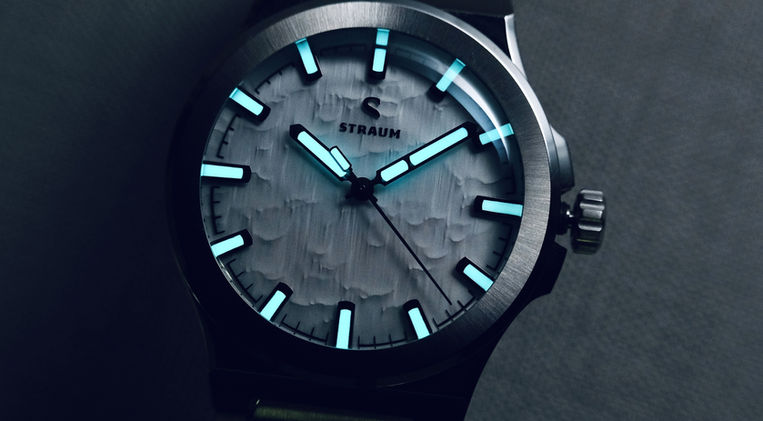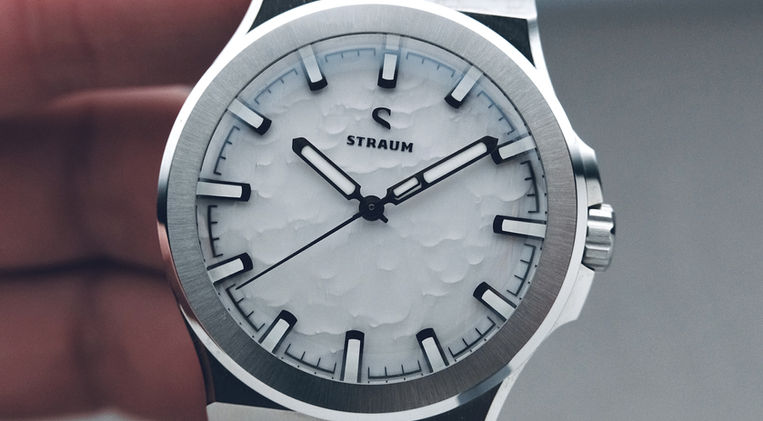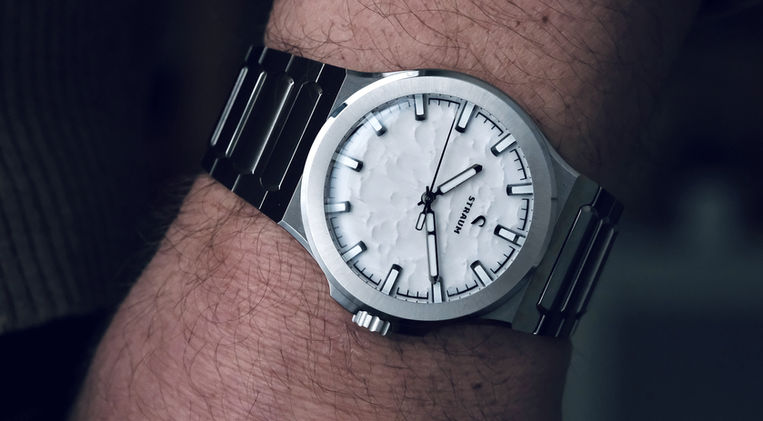Straum Jan Mayen Glacier White
The Most Accomplished Modern Exploration Watch
April 9, 2025
We now mostly have a deep emotional connection to (analog) watches. Even though some claim to do, we don’t need them at all in our modern lives. But we prefer to wear them. It’s a choice we make over using a smartphone or smartwatch to keep track of time. And through them, we attempt to emulate certain feelings, certain ways of life, often rooted in the past, dreaming of the days of debonair explorers, brave souls which put their lives at risk to discover new parts of our world…just because. So some of us like to wear exploration/adventure watches, whether they look like the old deal or are modern interpretations of them. And what sets some brands apart from the limitless market of independent horology is a design and how it is matched (or not) to a spec list. These watches are supposed to be legible and reliable so that they can follow us on adventures near and far.
In 2025 there are countless options for this type of watch at all price points. Many are straight-up homages of iconic models, others are re-interpretations of those same ones, and some others—but fewer of them—are genuine and unique horological creations. They borrow the spirit of the original exploration watches (i.e. the Rolex Explorer 1 and the Seiko Alpinist) but come with a new visual spectacle that is deeply rooted in the country in which these watches were designed. And today we’re going to look at one of the most singular yet instantly classic of those, the Straum Jan Mayen Glacier White. Heralding from Norway, Straum found its own way to celebrate the unique geographical features and natural landscapes of the country, and to distill them into one incredible collection. Complete with the right specs and unique mechanical features, the Jan Mayen is, perhaps, the most accomplished modern exploration watch to date.

Specifications
As I just claimed it to be so, the Straum Jan Mayen does indeed come with a long list of great specifications that make this model easily earn the title of a capable modern tool watch—of the exploration type. And as we will see later when discussing its design, the Jan Mayen is visually versatile and the type of a watch yours truly would feel comfortable wearing exploring an icy island (the Norwegian volcanic island this collection is named after) just as much as I would walking the carpeted floors of Geneva’s Palexpo during Watches & Wonders. (I know, a very specific image I just used here.) That means the Straum Jan Mayen is indeed a watch that can do it all and at any time and anywhere, exactly the type of horological creations I am smitten with and which you can also (and should) have an appreciation for. Trust me on that one.

So what we have here is, first and foremost, an incredible case—from finish and design perspectives—which commands a confident wrist presence yet one which comes with average good dimensions: 38.7mm in diameter (or 40.7mm including the crown,) 45.7mm lug-to-lug (or 42.5mm from the drilled lug holes), 11.5mm thick (or 9.7mm excluding the crystal,) and coming with a 24.8mm lug width. There are already two things to note here: (1) Straum wants you to know exactly how the watch will wear on your wrist whether on the bracelet or using another type of fastening system (e.g., rubber strap or nylon;) (2) by default the Jan Mayen has an integrated bracelet design, though the brand has engineered an universal strap adapters so that you can use any 20mm straps you have (yes 20mm and not 22mm) as well as a micro-adjustment clasp so that the outstanding bracelet fits your wrist even better.

Note: the latter two accessories can be purchased separately; $100 USD for the strap adapters and $120 USD for the micro-adjust clasp, which adds $220 USD to a $1,700 USD watch but we will talk more about prices later on.

Moving onto the rest of the specs we have a La Joux-Perret G101 caliber inside this beautiful case, beating at 4Hz and coming with an impressive 68 hours of power reserve. Straum opted for the “Soigné” grade of the G101 which means the movement is adjusted in four positions to run at +/- 7 seconds per day. (The brand’s website includes additional information such as “Max divergence on all positions” of +/- 20 seconds per day and “Isochronism” at +/- 15 seconds per day—you can learn about the latter here.) And it keeps coming: screw-down crown and case-back for 100 meters of water resistance; loads of blue-glowing SuperLuminova on the hands and markers; double-domed sapphire crystal with inner anti-reflective coating; drilled lug holes and what the brand calls 130% links (third-links) to get a better fit of the bracelet should you opt out of the micro-adjust clasp. (Or using both concurrently you’re guaranteed the perfect fit.)
As you can tell, Straum didn’t cut any corners on the spec list since the Jan Mayen was created to be an actual and modern exploration watch.

Design
Starting this review I didn’t expect to spend so much time discussing specs but here we are. And be warned that I have just as much to say in regards to the design! I do not claim to be Neo and to have access to a database listing all watch design elements since the invention of the first clock, allegedly in 14th century B.C. Egypt, but I can say that most of what you’re seeing on the Straum Jan Mayen is unique. More than that, some of these elements appear like something else we’ve seen before but they actually aren’t. It’s something that’s quite fascinating to be frank with you as I don’t believe it’s an easy task to redesign something we’ve seen a million times and to create a cohesive design language across the dial, case, and bracelet. At the risk of sounding like a broken record already, the Straum Jan Mayen is indeed something quite special.

Let us begin with the dial then which is the one of the many stars of the show. While we’re looking at the Glacier White variant, there are currently 10 versions of the Jan Mayen—four distinct dial textures that come in various colors. For example, the Glacier White and Black Sand variants have the same dial texture but evoke two different landscapes of the island. The Glacier White represents the windswept glacier surface of the Beerenberg volcano while the Black Sand references the black volcanic sand coastline of Jan Mayen. Although generally yours truly prefers black or grey dials, I’m glad I got to review the Glacier White as it is the version that—to me—best evokes a natural landscape. I haven’t been to Jan Mayen but I’ve had the privilege of seeing that same pattern whilst skiing in the French Alps on one many frosty and windy days.

And in my very own experience of looking at many nature-inspired watches, this dial texture + color combo is one of the best executed I’ve ever seen. (That of the Mitch Mason Maelstrom II is a close second.)

And there is much more to see on the dial of the Jan Mayen Glacier White. For example, the finely polished hour and minute hands that have a rounded, rectangular profile and shovel-like tips, and the polished needle seconds hand that also has a rounded rectangular counter balance. All three hands are lumed and glisten under any lighting conditions, an effect that is subtly reinforced by the shape of the crystal. The hour markers appear to be applied but are instead mounted on an invisible disc which sits just above the dial. But the markers are three dimensional and polished, and also filled with lume, which is quite the spectacle to behold. Contrary to the latter, the minute track is printed onto the dial and here in black so that it’s easy to spot. (Although the Jan Mayen shines and dresses up nicely, it remains a serious tool watch and was extensively field-tested by the brand founders on Jan Mayen.)

Lastly, the case and bracelet. The former has an angular and masculine profile, stubby crown-guards at the 3 o’clock, slab-slided flanks, and a fixed bezel which sits proud of the mid-case thanks to a pronounced undercut. The majority of the case is brushed except for the polished slope on the bezel and the chamfers of the mid-case where the polishing overtakes the upper section of the crown-guards. Straum opted for an innovative use of surface treatments to highlight the angularity of the case in a way that it creates a spectacular visual effect. The bracelet is something quite ingeniously designed as well where massive center links are finished with polished chamfers on either ends and the side/intermediary links are fully brushed. Moreover, the bracelet tapers from 24.8mm at the lug to 18mm at the clasp, therefore dramatically tapering down by 6.8mm. This is visually and practically superb.

The Heart of the Matter
It’s about damn time that we reach the section of the review where I generally attempt to say something meaningful to you the reader about the watch we just talked about. I know I’m generally very enthusiastic about the watches I review because I cannot bring myself to waste my time and yours typing too many words about a watch I feel wouldn’t be worth our communal attention. And you may know I have a soft spot for utilitarian horology, generally with black or grey dials, and minimal features. So of course I was very keen to write about the Straum Jan Mayen as it is the type of watch my little French horological hurt flutters for. Because it is well built, because it has great specifications, and because it has a singular design which, strangely perhaps, looks familiar. It isn’t a “same same but different” kind of deal, however, as the Jan Mayen is something that looks unique, not only on account of its design, but more so on account of its soul.

Wow, things are getting deep here but hear me out for a second. At first glance, you may see design elements of other watches which have preceded the Jan Mayen. From ultra luxury brands which have made distant-like-sibling-kind-of integrated bracelet sport watches, and more affordable but equally iconic models and a shovel-load of homages and re-interpretations of these kinds of watches. The bracelet is perhaps the one element of the Jan Mayen which evokes something else the strongest, but Straum went as far as re-engineering the bracelet and adding unique features which the giants of horology never bothered making—strap adapters and a micro-adjustment butterfly clasp. And nature-inspired textured dials are nothing new either, but there Straum worked out the details ad nauseam to perfectly represent landscapes of a Norwegian island in ways that I’ve rarely seen before. So where does that leave us? With a complete and singular horological package complemented by the right specs.
A modern exploration watch indeed.

Conclusion
A regulated La Joux-Perret G101 caliber + domed sapphire crystal + 100 meters of water resistance + good lume + singular design + bold yet classy aesthetics + a full bodied character = a unique watch. And what is unique is generally more difficult and more expensive to make (for the brand) and to purchase (for the customer) which is why the Straum Jan Mayen retails for $1,700 USD excluding taxes (which you won’t pay if you order from outside the EU.) Though I would argue that’s a reasonable amount to pay for what you get here—again a singular piece of horology that is so well thought out and put together that it can easily rival and put to shame many models from luxury brands and higher micros alike. This puts Straum and the Jan Mayen in a category of their own which one has yet to officially recognize and named.
In the meantime, I suggest taking a look at all versions of this super watch on the brand’s website.
Thanks for reading.








































